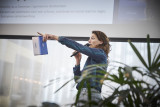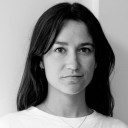Recap of Demoday #19

The first Demoday of the year was a great success! A lot of familiar and new faces gathered at DB55 for an afternoon full of inspiration, exchange and connection with each other. In this article, we give you a quick overview of the Impact Workshop, pitches and worksessions. Interesting in learning more? Read the full reports by our Programme Managers Sophie, Jessica and Pelle (linked below).
About our Demodays
The Demodays are one of the tools we use to stimulate innovation and encourage connection between our partners and community. The purpose of the Demodays is to present the progress of various innovation projects, ask for help, share dilemmas and involve more partners to take these projects to the next level. More information about the Demodays can be found here.
Impact Workshop
We started the Demoday with a workshop about ‘Measuring the impact of our network’. At the start of our new programme period, our partners have expressed their wishes to make the impact of our organisation, events and projects more measurable so that we can share and learn from each other. Our colleague Antonio Carretero from the Amsterdam Economic Board has developed an impact framework with four impact lenses that can help managing change in a different way. Read all about it here.
Pitches
After the Impact Workshop, we continued with four inspiring pitches. Susan van Esch and Bas Schilder (phbm) added a useful instrument to our toolbox for Smart City projects: the “bewustwordingsmatrix” (the awareness matrix), Bas Ruis told us more about the FIXbrigade and their plans for the future, Yanti Slaats (Amsterdam University of Applied Sciences) gave us an update about CIRCOLLAB and Mariana Garcia E. (World Benchmarking Alliance) pitched the Urban Benchmark Methodology which is currently in development.
Worksessions
Digital | CommuniCity project, by Neeltje Pavicic (municipality of Amsterdam)
Through the CommuniCity project, the municipality of Amsterdam is looking for a structural process for matching the needs of vulnerable communities to solutions of tech providers. In this worksession, the network discussed the current bottlenecks for developing tech for vulnerable communities and potential next steps. Curious about the outcomes? Read the full report by Programme Manager (Digital) Sophie here.
Mobility | Mobility as a Commons, by Job Pék (municipality of Amsterdam)
Cooperative shared mobility or Mobility as a Commons (MaaC), in which vehicles are managed and owned by a group of local owners, can offer opportunities for residents and the city. At the Demoday, Jop Pek and Diederik Basta explained more about Mobility as a commons, and reflected together with participants. Read more in the report by Programme Manager (Mobility) Pelle here.
Energy | 15% GasTerug initiative, by Laetitia Stuit (Amsterdam Economic Board)
The action network 15%GasTerug has been working hard to achieve the goal of 15% gas usage reduction since the war in Ukraine broke out. They reached this goal in January this year and asked the Amsterdam Smart City to help make the impact more visible to the public in this worksession. In the session, led by Remco Marinus from Havas Lemz, the participants brainstormed about possible newspaper headlines on 15%GasTerug. Want to know what they came up with? Read the full report by Programma Manager (Energy & Circularity) Jessica here.
The next Demoday is on Thursday the 16th of May. Do you have an inspiring story or project you want to pitch to the Amsterdam Smart City network? Let us know via sophie@amsterdamsmartcity.com.






